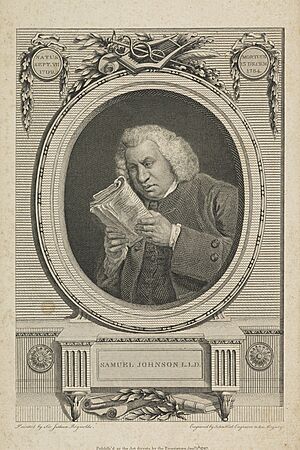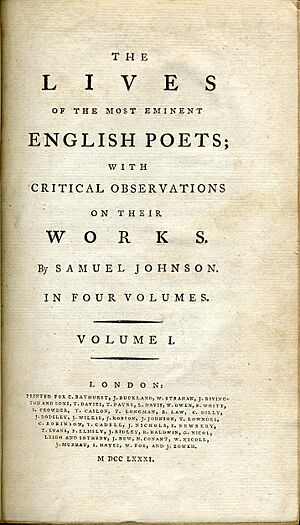Lives of the Most Eminent English Poets facts for kids
Lives of the Most Eminent English Poets (1779–81), also known as Lives of the Poets, is a famous work by Samuel Johnson. It includes short biographies and critical reviews of 52 poets. Most of these poets lived during the 1700s. Johnson arranged the poets roughly by the year they died.
After the 1700s, new and updated versions of Johnson's work were published.
Contents
How the Book Came to Be
Samuel Johnson started writing biographies in 1740. His first ones were about people like Robert Blake. In 1744, he wrote his first longer biography, Life of Mr Richard Savage. This was about his friend, Richard Savage, who had passed away.
There are different stories about how Johnson came to write Lives of the Poets. One story says that Scottish publishers began selling collections of English poets' works in London. This was seen as a problem for copyright in England.
So, in 1777, a group of London publishers and booksellers asked Johnson for help. They wanted him to write short biographies for their own collection of poets. Johnson agreed to do it for 200 guineas, which was less money than he could have asked for. Soon, advertisements appeared, announcing "The English Poets, with a preface biographical and critical, to each author."
Johnson took his time writing the book. In 1777, he wrote that he was busy preparing "little Lives and little Prefaces." When asked if he would write about "any dunce’s works," Johnson famously replied, "Yes, sir; and say he was a dunce." However, he did suggest adding some poets himself, like John Pomfret and Isaac Watts.
As he wrote, many of the biographies grew longer. This slowed things down. Each biography now included the poet's life story, a summary of their personality, and a review of their main poems. In 1779, the publishers decided to release the 56 volumes of poems first. Johnson's biographies would come out separately as he finished them. At first, only people who bought the full set of poems could get the biographies. But in March 1781, the collected biographies were sold separately as a six-volume work under the title we know today.
What the Book Covers (and Doesn't)
Most of the biographies in the book were written especially for this series. Johnson did use his earlier Life of Richard Savage with only a few changes. An article about the Earl of Roscommon was also updated to fit his plan. Some parts, like the review of William Collins, had appeared in other books before. The biography of Edward Young was actually written by Sir Herbert Croft, a friend of Johnson's.
Even though the book focused on poets who had died, some recently deceased poets were not included. For example, Charles Churchill (whom Johnson didn't approve of) and Oliver Goldsmith were left out. This might have been due to copyright rules.
Also, Johnson's book completely left out women poets. This decision was later criticized. Some people believe that a new edition of Poems by Eminent Ladies (first published in 1755) was reissued in 1785 to fill this gap.
Not all the facts in Johnson's book have proven to be completely accurate. Many of his critical opinions were seen as unfair or biased, even at the time. For example, he was very critical of Milton's poem Lycidas and Gray's Odes. He also seemed to have a strong dislike for Swift. Johnson also gave a harsh description of the "Metaphysical style" of poetry in his biography of Abraham Cowley.
List of Poets in the Book
Here are the poets included in Johnson's Lives:
|
|
|
How Other Writers Responded
Even though Johnson's writing was excellent, his critical opinions caused immediate reactions. One of Johnson's own friends, John Scott, disagreed with some of his judgments. Scott wrote his own essays about works by poets like John Denham and Pope. These were published in 1785. Scott felt that Johnson's choice of poets for the collection lacked a clear method or "fair criticism."
In the same year, a new edition of Poems by the Most Eminent Ladies of Great Britain and Ireland was released. As mentioned before, many believe this new edition was a direct response to Johnson's book not including any women poets. The editor of the 1785 edition didn't say so directly. However, comparing the lists of poets shows that the new edition included more female authors.
Later, between 1821 and 1824, Henry Francis Cary published essays that continued Johnson's work. These essays, published after his death, were called Lives of English poets, from Johnson to Kirke White. They covered 17 poets and followed Johnson's style. They included biographical details, character studies, and reviews of the poetry. The longest essay was about Johnson himself.
Creating a Standard Collection of English Poets
Robert Anderson introduced his book, A complete edition of the poets of Great Britain (1795). He stated that when a new collection of poetry is offered, people will ask what was missing from older ones. Anderson then reviewed earlier collections. He noted that the 'Johnson edition' started the English poetry collection too late, only in the second half of the 1600s. Even when 14 more poets were added in 1790, it still wasn't complete. Anderson aimed for a more ambitious set of poets, starting from Chaucer. He also included more Scottish poets. Anderson wrote the biographies for his collection himself.
Alexander Chalmers also created a large collection called The Works of the English Poets, from Chaucer to Cowper (1810). For the poets who were in Johnson's edition, Chalmers kept Johnson's biographies. In his introduction, Chalmers admitted that Johnson's biographies "must ever be the foundation of English poetical biography." By including them, Chalmers showed a link between Johnson's work and his own goal of creating a "Body of the Standard English Poets."



